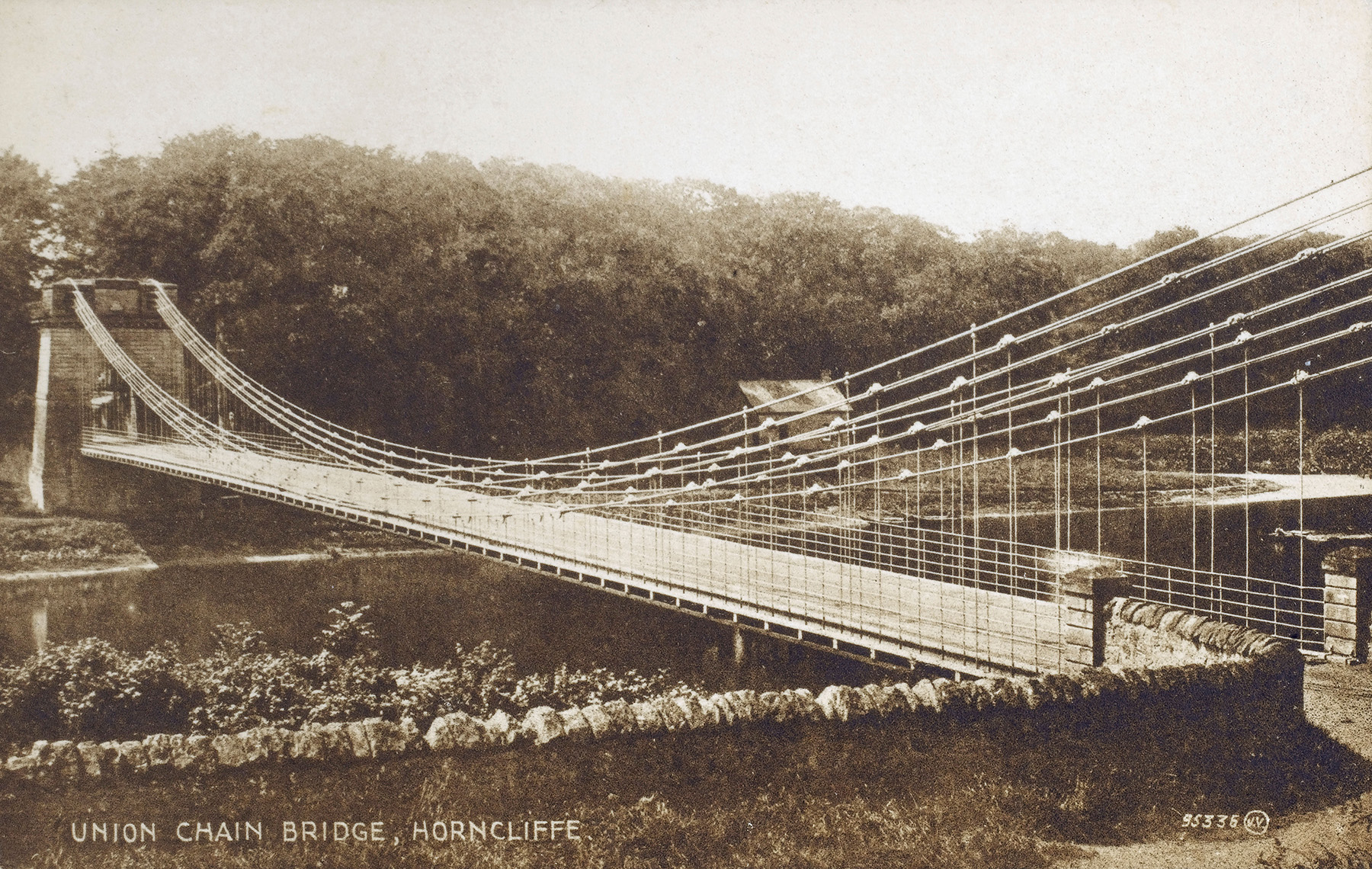
On July 26, 1820, spectators were so eager to stand on Capt. Samuel Brown’s first suspension bridge, they broke through barriers to reach the wooden platform. Though the official opening-day ceremony was chaotic, it was clear Brown’s design was a success. The 449 ft long span over the River Tweed connects Horncliffe in Northumberland, England, to Fishwick in Berwickshire, Scotland. It would become the world’s oldest vehicle suspension bridge.
Brown, an Englishman, had been serving in the Royal Navy for nearly 12 years before he was given the chance to change a key aspect of how ships functioned. At the time, all rigging and anchoring cables were made of hemp, a material that snapped, eroded, and emerged from the ocean slimy and foul smelling, notes John Harland in The Transition from Hemp to Chain Cable: Innovations and Innovators. By the end of the 18th century, however, wrought iron was improving in quality and dropping in cost. Iron chain cables were more durable, and Brown realized that they were an easier-to-maintain alternative to the fiber cords he and his shipmates once struggled with.
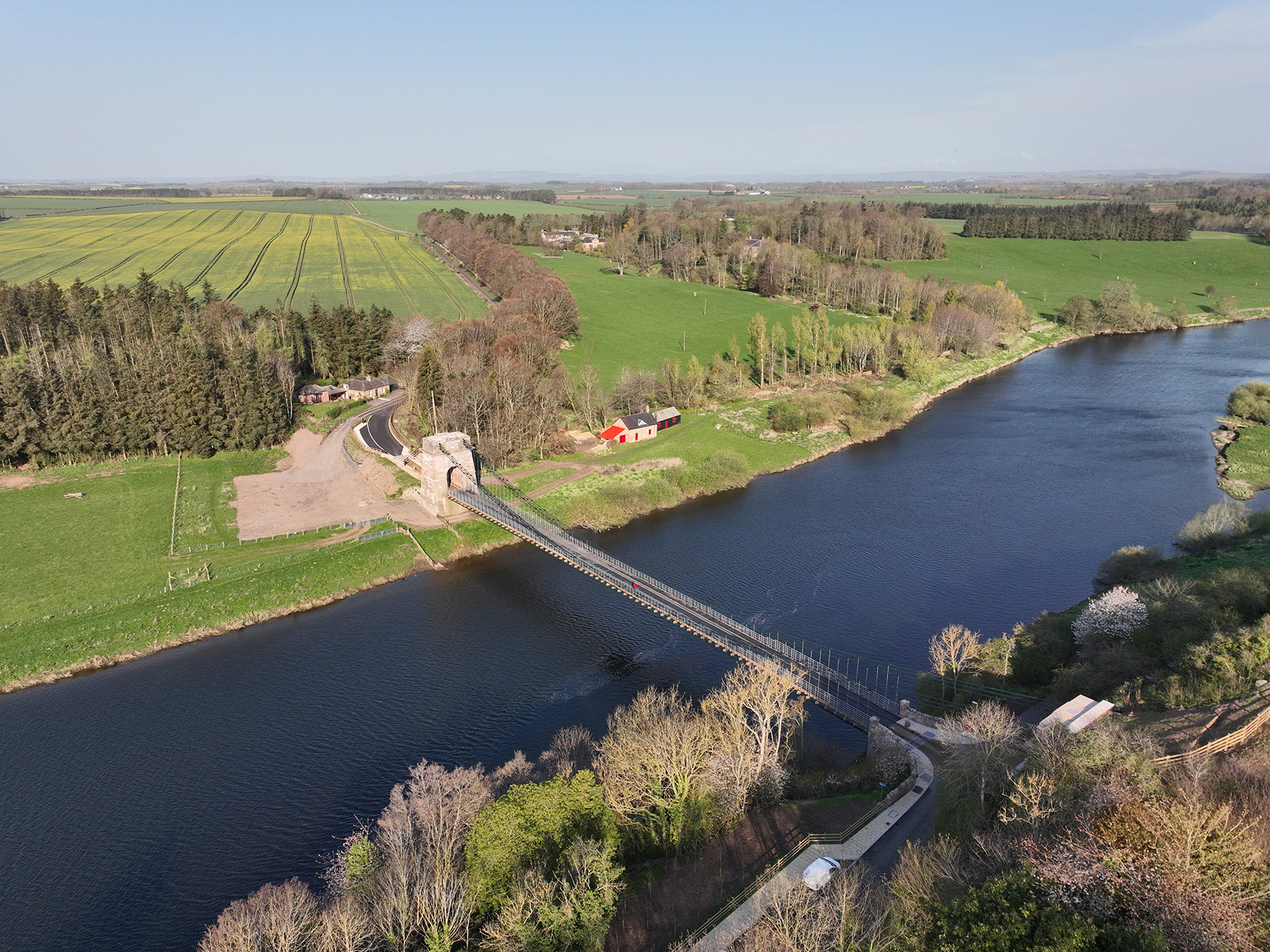
After developing his own iron chain designs and strength-testing them against hemp renditions, Brown persuaded a few private ship owners to use his designs on their vessels. One, the Penelope, set sail with iron cables, stays, and rigging in 1808 and made a successful trip to the West Indies and back. By 1811, the navy had bought Brown’s designs for ground tackle, giving him the financial freedom to retire from the navy a year later, per Gordon Miller in the article “Union Chain Bridge: linking engineering” in the journal Civil Engineering. (Proceedings of the Institution of Civil Engineers, Vol. 159, Issue 2 (May 2006))
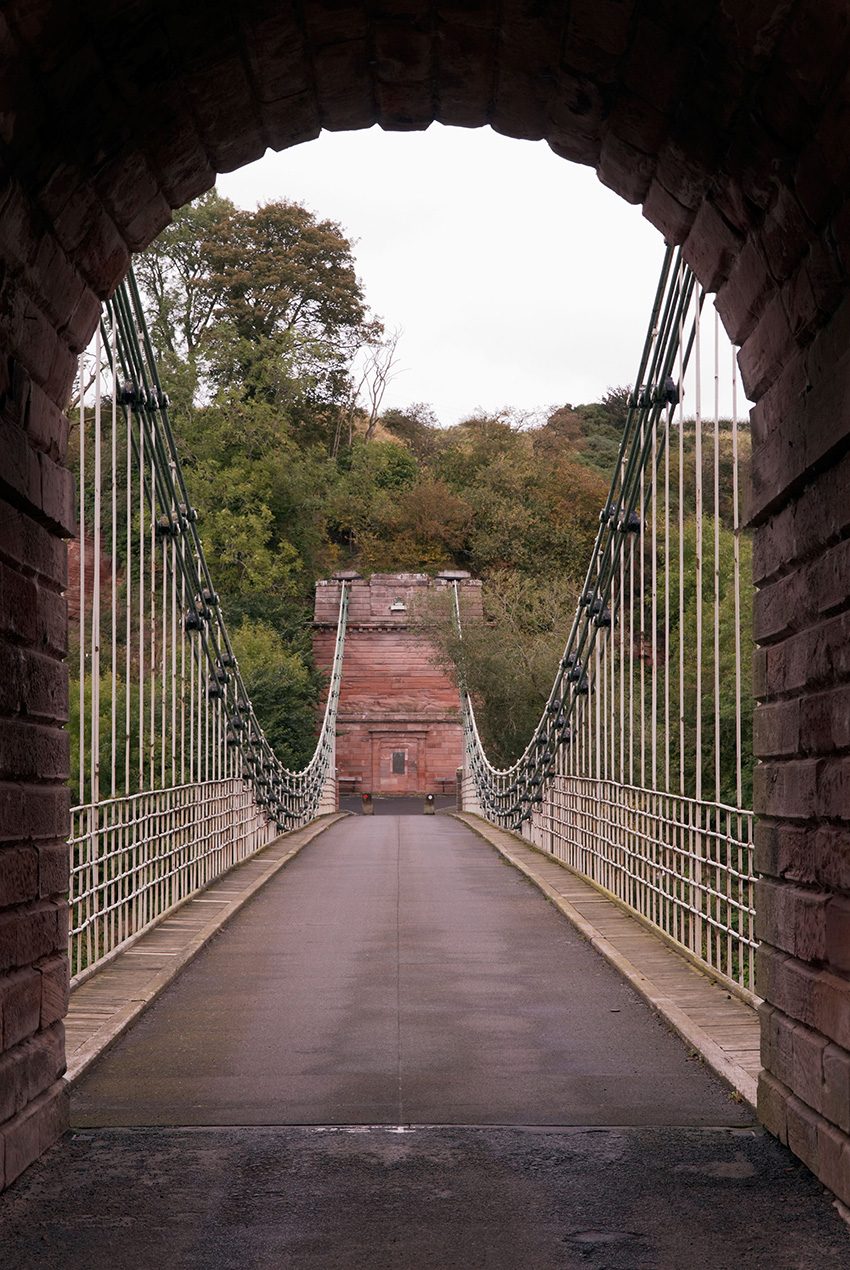
The 36-year-old retiree, who by this point had partnered with his cousin Samuel Lenox to open the chainworks company that eventually became known as Brown Lenox & Co. Ltd, continued tinkering. At his east London factory on the Isle of Dogs, he built a 105 ft long prototype of a chain link bridge — one stable enough that Scottish civil engineer Thomas Telford rode across it in a carriage. The design would go on, with some tweaks and modifications, to become the Union Chain Bridge.
Why Brown wanted to expand into bridge construction is a mystery. He was not a civil engineer, and his chain manufacturing company was already functional and profitable. From 1816, it had a nearly exclusive contract with the Royal Navy that ended up lasting until 1916.
“I’ve often wondered why — as he was so successful in supplying chain cable not just to the British navy but navies throughout the world — (he) felt the need to go into other areas,” says Stephen K. Jones, LGCI, FICE, a trustee of the nonprofit Friends of the Union Chain Bridge, who has spent time researching Brown Lenox. Perhaps Brown had the idea and the eyebar equipment and thought it was worth a try.
No matter the motivator, Brown devised a bridge design that hooked five iron rods together at a single connection point. Saddle joints along the length of the bridge chains serve as spots for eyebars to meet but not interlock. Capped pins go through the ends of each eyebar chain to keep it in place against the joint. Each flexible joint is double-sided, meaning it brings together the links of two separate chains at a time.
Sitting in the center of the joint is a segment from which suspension rods hang. In turn, the suspension materials connect to more iron that runs parallel to the river below, creating a foundation for a wooden deck. Brown patented his process for making these chains and the bridge design in 1816 and 1817, respectively.
As Brown was building his iron business and designs, the United Kingdom was building paths. Parliament authorized trusts around the country to foster road creation. The so-called Turnpike Acts allowed local not-for-profits to repair and improve given sections of roads (and to levy tolls to pay for upkeep). One such entity, the Berwick and North Durham Turnpike Trust, obtained permission to place a bridge across the River Tweed in a stretch that otherwise was navigable only when water levels were low enough to ford.
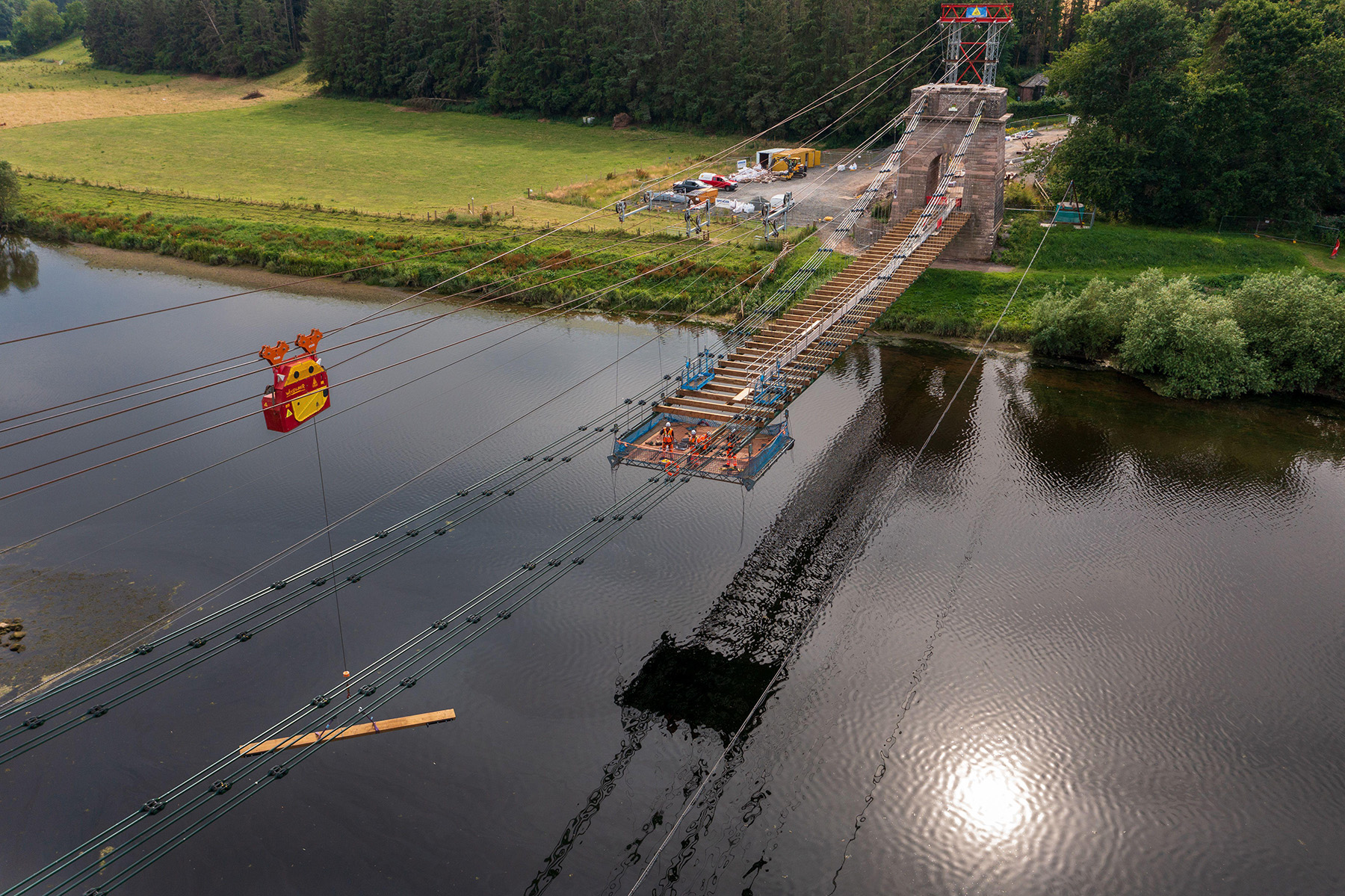
How Brown acquired the contract to build the crossing is not entirely clear. At the time, one of the people responsible for some of the national turnpike legislation, George Home, was related through marriage to a navy admiral whom Brown knew. Miller and Jones, who co-authored the book Samuel Brown and Union Chain Bridge, speculate that these connections worked to Brown’s advantage.
Brown proposed a signed drawing to the trust in 1818, which led to deliberations on where the hypothetical structure should cross the Tweed. Avoiding possible floodwaters at secure anchoring locations that required minimal approach road construction helped Brown and the trust choose an east-west alignment with a sandstone outcrop on the English side of the river. Though the rocky face required some changes to ease bridge access — a cut and fill would have to make space for an approach road — the sandstone also served as an anchor for the bridge.
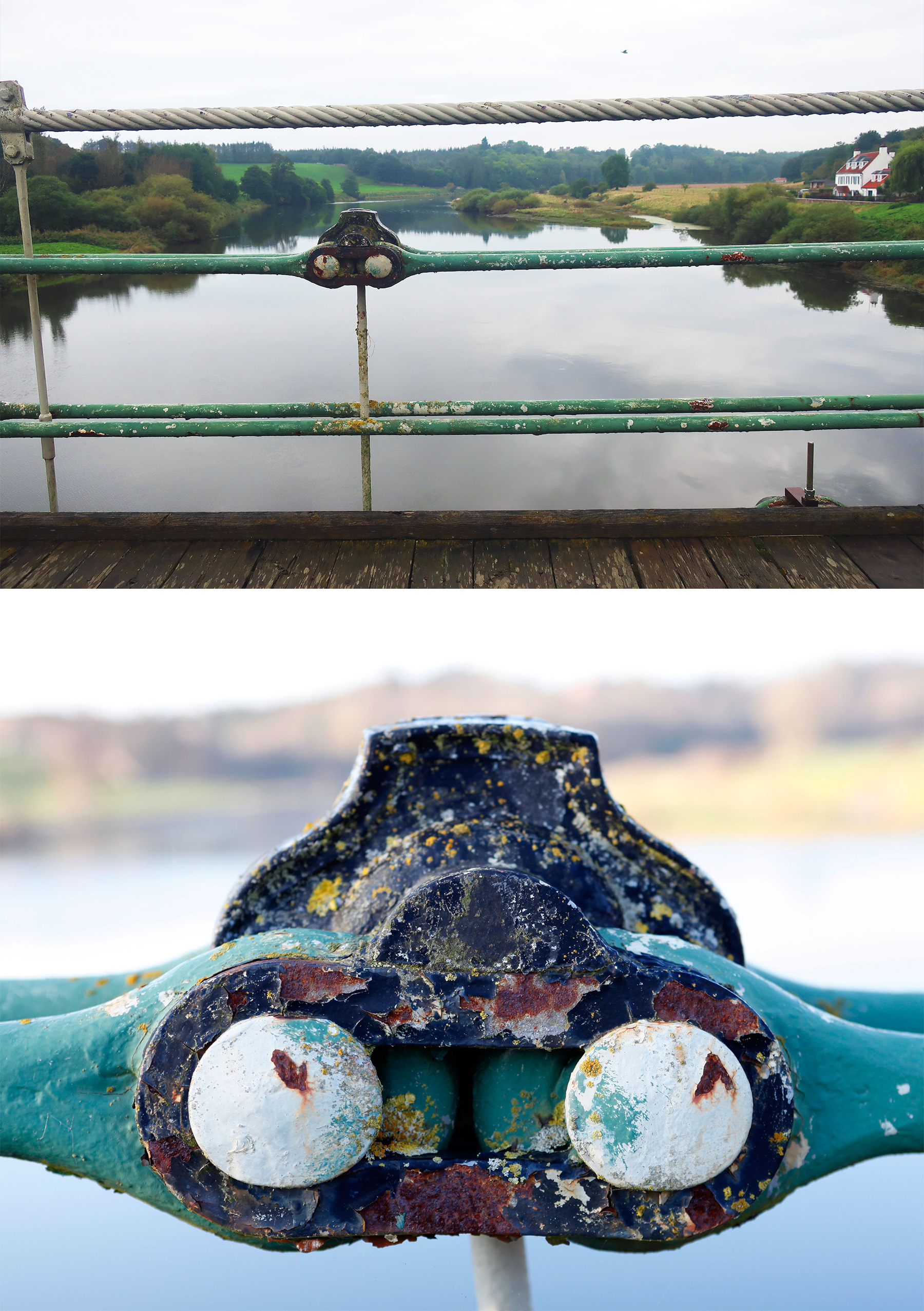
By July 1819, designs were final enough that the trust threw a celebratory dinner in a tent pitched next to the bridge foundation stone. The group capped off the festivities by cementing to the foundation stone a Berwick newspaper, a bottle filled with coins, and an inscription on a copper plate (though a local paper reported the money was eventually stolen).
The same year, Brown began building the bridge by manufacturing its iron components in his Pontypridd, South Wales, facility, his second. Each finished chain component was proof-tested on equipment Brown had also designed. Pay was piece rate, and laborers were compensated only if their work passed inspection.
Approved metalwork was lowered through a hole in the testing shop floor to be loaded on a barge which floated down an adjacent canal. From there, the cargo was transferred onto a ship and then a river craft before workers could sail the chains down the Tweed to the construction site, Jones says.
Heaving the ironwork between boats must have been a burden: Each catenary chain fully assembled weighed 5 tons, and as the design evolved, the chains became longer and more numerous. In the final iteration, Brown installed not one but three pairs of catenary chains on either side of the bridge. In addition, the number of suspension rods increased (spacing between the joints eventually shrunk to only 5 ft), and the chains spanned 425 ft instead of 392 ft, according to the authors in Samuel Brown and Union Chain Bridge.
Before assembling the iron components, laborers likely slathered the metal in boiled linseed oil to ward off oxidation and rust. No known records describe how workers maneuvered the weighty chains into final position. Documentation from similar bridges built after Union Chain suggest that crews likely built scaffolding on either bank and used small ropes to haul progressively larger ropes — and eventually the chains themselves — from one side to the other. Keeping the smooth catenarian arc and making sure suspension rods were the right height so as not to create irregular bumps in the curve also required on-site length adjustments of different hangers.
Masonry pillars on either end of the bridge helped create (and hide) bridge attachment points. On the Scottish side, workers left gaps in the 60 ft high pillars to let chains pass through and over rollers before reaching cast-iron ballast plates 24 ft underground. An iron bolt 3 in. long and 3.5 in. thick kept the chains to their anchors, which were 6 ft long, 5 ft wide, and 5 in. thick.
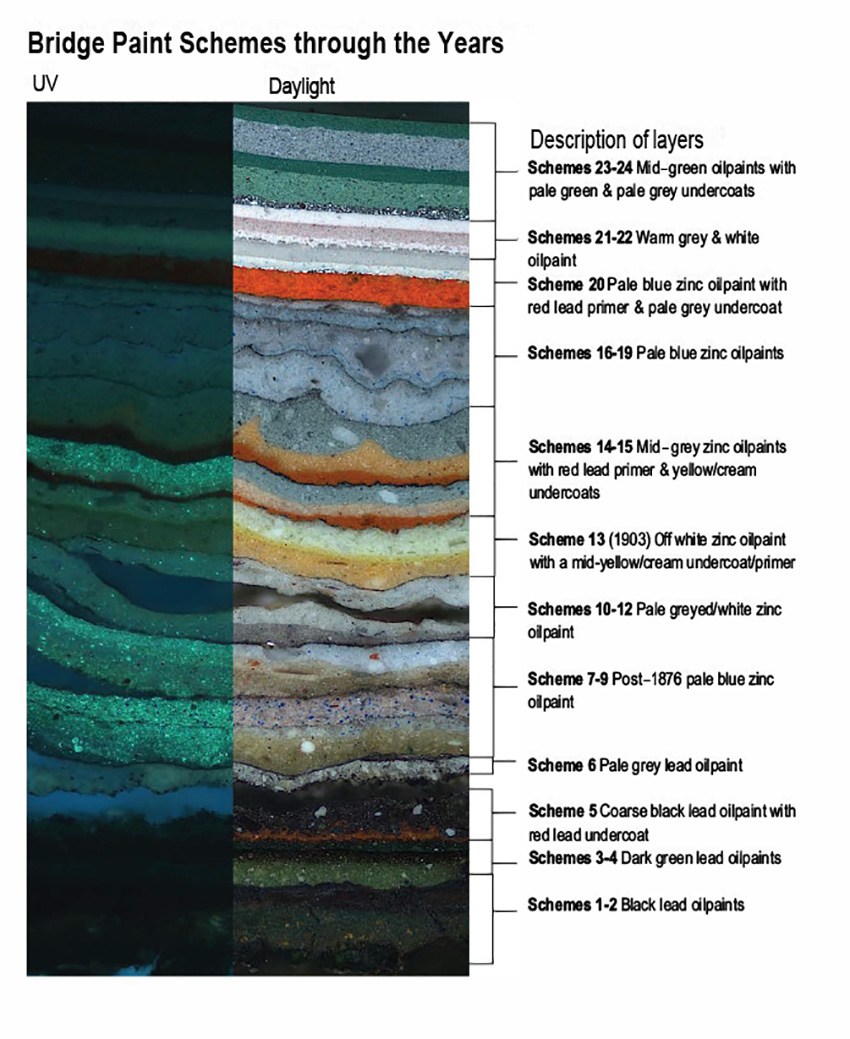
On the English side, workers built a 20 ft high masonry pillar on a foundation that was excavated into the sandstone rock, according to writings by civil engineer Robert Stevenson, who published detailed descriptions of the bridge construction in the 1800s, according to Miller and Jones.
Instead of passing through the masonry on rollers, the catenary chains on this end “rest” on cast-iron ballast plates that are the same dimensions of those on the Scottish side. The plates, which are not underground but within the masonry, were “placed so as to correspond with the direction of the strain or weight of the bridge,” Stevenson wrote. “For the greater security of the position of these ballast-plates on the English side, they are connected with a horizontal arch of masonry, which is dove-tailed into the rock.”
By the project’s end and the raucous opening day, Brown’s cost of construction had risen due to complications as well as the additional chains and suspension rods he incorporated into the design. Instead of the 4,900 pounds the trust had originally agreed to pay him, the work ended up costing about 7,700 pounds, a total that still brought construction costs well below what a comparable masonry bridge would have cost. After some letters back and forth and a final awkward missive that, Miller and Jones think, must have been “an embarrassment to the Trustees and the Clerk,” Brown was fully paid and free to focus completely on future construction.
Though most of his other bridges are not around today, Brown’s Union Chain construction functioned for nearly two centuries, albeit with additions to keep the bridge structurally sound. New cables for extra support were installed in 1903, and in the 1970s, the entire wooden deck and large portions of the ironwork were replaced with steel wire cables. Eventually, however, it was clear the bridge would need a more comprehensive overhaul.
Project 2020 (a local action group) and the Friends of the Union Chain Bridge joined forces in the 2010s to help the two local government entities the bridge reaches, the Northumberland County Council and the Scottish Borders Council, secure renovation funding. In 2019, the bridge preservation initiatives won a grant of 3.14 million pounds from the National Lottery Heritage Fund. Additional backing from the two councils and numerous foundations as well as grants bolstered the restoration budget.
The bridge officially closed in October 2020 for what would be an almost complete dismantling. Crews with Spencer Group, a British engineering firm contracted for the renovation, installed a ground anchor beam in the embankment above the masonry tower on the English side and two ground anchors on the Scottish end to accommodate a five-cabled mini-suspension system. An under-deck gantry and personnel cradles, along with a cable crane, allowed workers to disassemble the bridge from above.
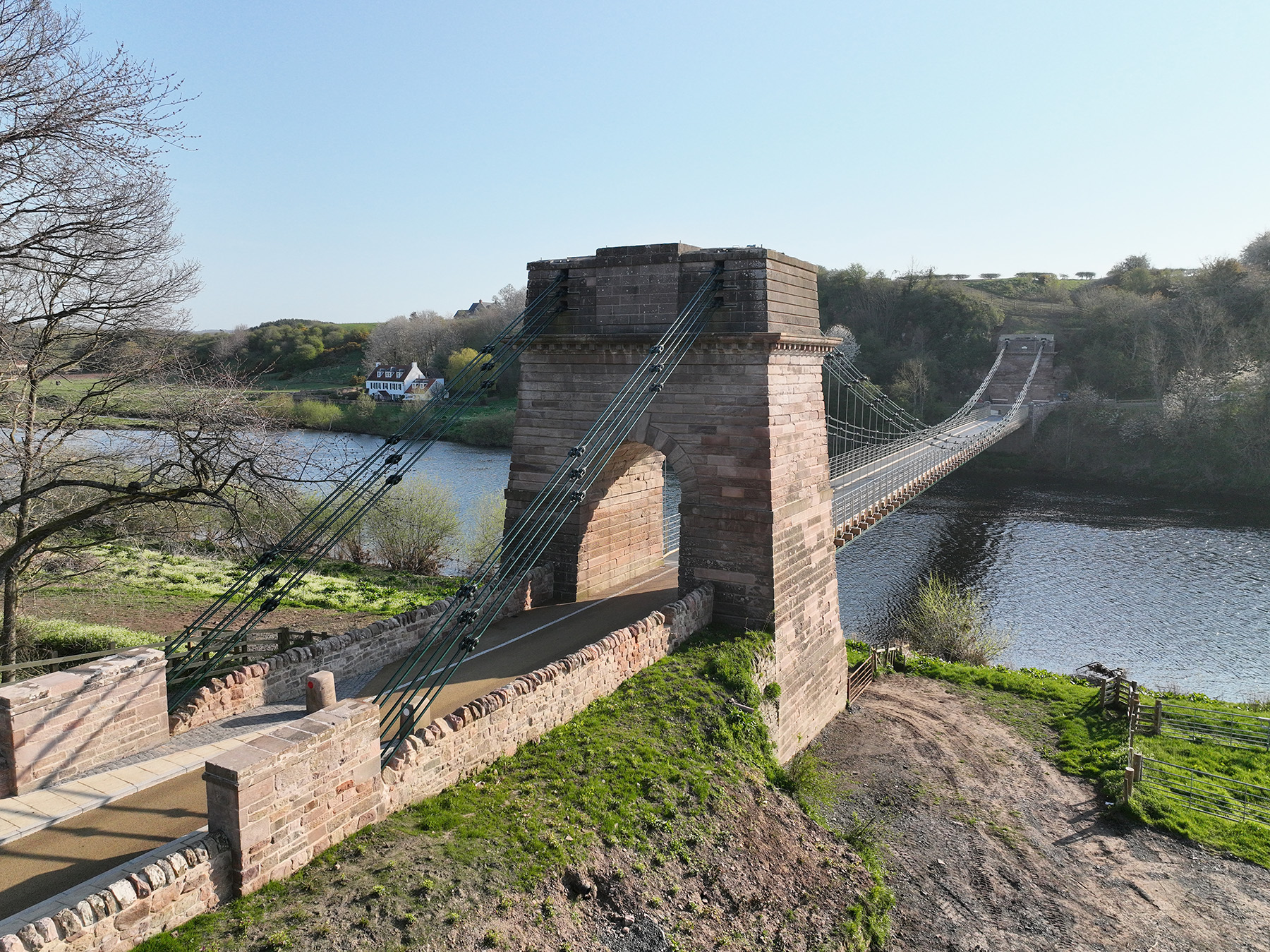
from the same quarry that Brown sourced from in 1819. The Scottish tower is shown here. (Photograph courtesy of the Spencer Group)
The cables installed in 1903 were the first to be removed — a survey showed they were not actively supporting the weight of the bridge and would only be helpful during a catastrophic failure — followed by the timber deck components. As the chains were wound up on winches and detensioned and disassembled, workers recorded the locations of all the bar links.
Disassembly of the more than 3,700 chain components allowed each one to be tested for degradation and strength. Those that could return to service were blast-cleaned and treated with an anticorrosion aluminum metal spray and paint — the same coatings that new replacement iron pieces received. Ultimately, 248 iron pieces original to the bridge were reused.
Preservation efforts extended all the way to the deepest and most hidden parts of the bridge. Both anchorages have new support systems, with the Scottish side — the one originally built with plates underground — receiving a 330 cu m block of reinforced concrete weighing 810 metric tons. Workers also inspected the integrity of the existing towers, replacing stone where necessary with sandstone from the same quarry that Brown sourced from in 1819.
The completed bridge, which opened on April 17, has all-new suspension rods, a blend of new and reconditioned chainwork, and a new timber deck to which Evergrip glass-reinforced plastic panels are affixed, according to the Northumberland County Council. An analysis of the paint layers on the old equipment performed by Crick-Smith, a conservation and restoration firm contracted by Spence and Dower, the conservation architect on the bridge renovation project, helped the designers land on the bridge’s original scheme: dark green chains with black links, pins, and hanger caps as well as stone-colored railings and cornices, per a March 2021 newsletter from the Friends of the Union Chain Bridge. The supports beneath the paint will also be able to handle 3 metric tons of weight, a boost from the 2 metric tons they originally supported.
Keeping the Union Chain Bridge operational means preserving not just the world’s oldest vehicle suspension bridge but also a relic from a specific period in history, Jones points out. The structure was built when engineers understood iron well enough to twist it into a support system but before trains became the dominant form of transit too heavy (due to the live loading) for existing suspension bridge designs.
And even though the Union Chain Bridge has been surpassed by crossings that could handle the heft of endless train cars, it left a mark on its contemporaries. “The very idea of a suspension bridge spanning the Tweed that was capable of supporting carts and wagons loaded with coal and limestone,” wrote Miller and Jones, “was to most people of the time a romantic dream.”
As of press time, the Union Chain Bridge is set to be dedicated as an ASCE International Historic Civil Engineering Landmark on July 6 in a ceremony at Paxton House in England.
Ted Green, P.E., M.ASCE, former chair of ASCE's History and Heritage Committee, shares his thoughts on the bridge in “Behind the Union Chain Bridge’s historic landmark status.”
Leslie Nemo is a journalist based in Brooklyn, New York, who writes about science, culture, and the environment.
This article first appeared in the July/August 2023 print issue of Civil Engineering as “The Union Chain Suspension Bridge Hangs On.”



